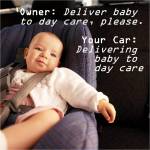02 Feb What happens when the horseless carriage goes driverless?

According to WIRED, “Google’s autonomous cars have driven 1.3 million miles since 2009. They can recognize hand signals from traffic officers and “think” at speeds no human can match. They’ve been involved in 17 crashes, but have never been at fault. Google’s previously predicted they’ll be road-ready by 2020.
An article on the Computerworld web site estimates that if 90 percent of vehicles were fully automated:
- 4.2 million accidents would be avoided
- Annual traffic fatalities would be reduced by 21,700
- Accident-related costs would drop by $450 billion
But with automated vehicles, who becomes responsible for accidents?
Leave no doubt – just as the “hay burners” of yesteryear were replaced as transportation, drivers may become a thing of the past. With many car models already sporting hands-free parking and rearview cameras, sensor technology is gaining a foothold among consumers. However, the future of driverless vehicles may not depend as much on technology as on laws and insurance coverage. Should an accident occur while your vehicle is under computer control, who’s at fault and who will accept responsibility for the victim’s property damage or medical bills? You? The manufacturer? The other “driver”? The victim?
Imagine this: You are zipping to work making coffee in your onboard Keurig, texting, reading the newspaper or watching the Today Show on your vehicle’s widescreen monitor. Suddenly your pod plinks a pedestrian. The vehicle sends a call for emergency assistance at your coordinates and a notice of the incident is flashed to the Department of Motor Vehicles. The onboard camera and sensors make a 360 degree scan of the scene and stores it in your pod’s “black box” while a copy of the report is sent to the manufacturer and their insurance company. Shouldn’t the vehicle have anticipated what the pedestrian would do? Now that would be something.
This is not the world of flying cars on the cover of some Popular Science edition. This is technology already employed and accelerating through the development curve. From a safety standpoint, it could be a wonderful development. From a liability perspective, humankind will need to play catch up.
The assumption is that if the vehicle’s technology removes operator error, then insuring an autonomous car would cost the owner a fraction of today’s prices. A survey by CarInsruance.com suggests that today about one in three people would opt for hands-free driving if it reduced their auto insurance premiums. That said, the vast majority of their survey respondents believe they could drive a vehicle better than a computer and 75 percent said they would not trust such vehicles to transport their children.
Nevertheless, the automotive industry, computer manufacturers and software designers appear to be making extraordinary progress in fusing their respective disciplines into an entertaining, informative transportation experience. The buzz grew louder at this year’s Las Vegas Consumer Electronics Show when a fully loaded Tesla Model S did virtual demonstrations of traveling in “autonomous driving lanes.” Nissan has set a goal of 2020 to introduce a fully automated vehicle and Google claims it will do so within five years.
So where does liability rest when an autonomous vehicle is involved in an accident? No one knows for sure because there are no laws or case precedents to guide us in this area. One assumption, though, is that the auto manufacturers and computer programmers would bear enormous responsibility if their products were found at fault. Complicating matters will be consumer demand for override technology despite the fact that about 90 percent of all accidents are related to human error.
Another report, by Navigant Research, predicts that by 2035, 95 million self-driving cars, about 75 percent of all light-duty vehicle sales, will be sold every year world-wide. The year 2035 incidentally is the same year depicted in the film iRobot starring Will Smith.
As an aside, all this activity portends a dramatic change in not simply law and insurance but also everyone currently associated with the “accident industry.” Currently, tens of thousands of people are employed in the auto accident business: tow trucks, insurance companies, litigation firms, car rentals companies, auto body repair businesses.
When accident rates plummet, the displacement in the workforce will likely create victims as well. The trade off of safety for job displacement may be worth it as we move safely toward new and, as yet, unimaginable jobs.



